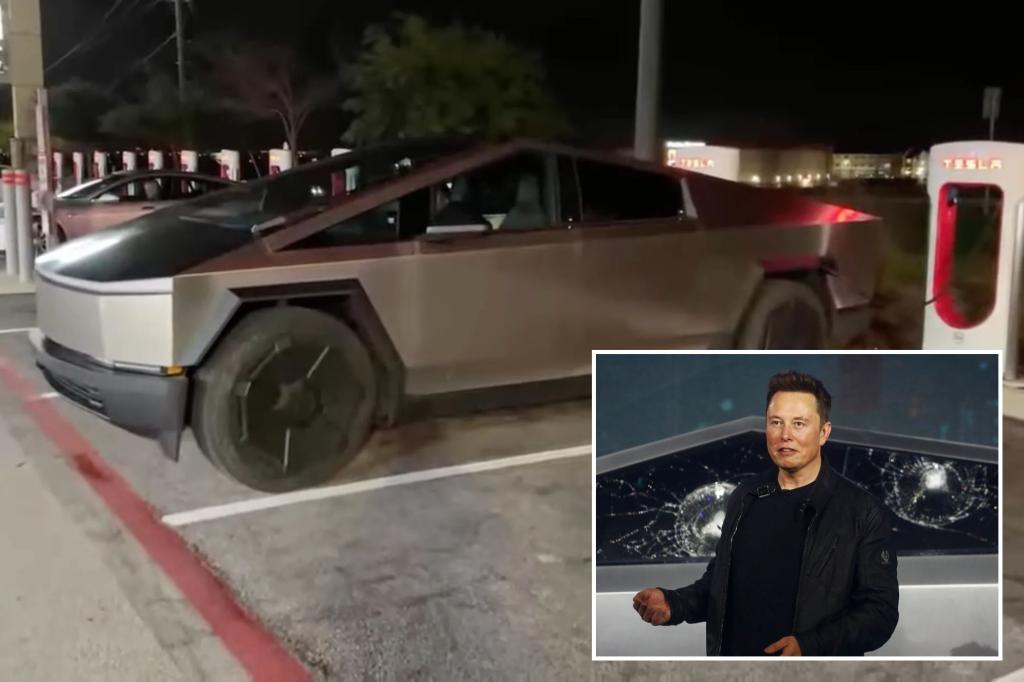Tesla Cybertruck gets less than 80% of advertised range in YouTuber’s test::A YouTuber took Tesla’s Cybertruck on a ride to see if it can actually hit its advertised 320-mile range, only to find out that its could only reach 79% of the target. When YouTuber Kyle Conn…
I hate Tesla and especially the Cybertruck as much as the next guy, but this was a highway test and that sounds like a completely normal result.
I own a Bolt EV which is rated for 259 miles of range. On the highway, that’s more like ~220. That sounds bad, but the other side of it is that I get ~300 miles of range during my normal work commutes through the city. This is just how EVs are, the estimated range is based on a mixed test. EVs are backwards compared to ICE, you’ll get ~20% less range than the EPA estimate driving highway speeds and ~20% more doing purely city driving.
I wrote this in another comment, but Tesla has been known for a long time to game EPA numbers. Here’s an article from 2020 talking about it: https://insideevs.com/news/407807/eletric-car-real-world-range-tested/
Several get below their EPA numbers, but several cars also get higher. Tesla models all get significantly below their claimed mileage.
The insideevs article reports 239 miles for a Model 3 Performance while clicking all the way through to the actual source of the testing “Whatcar” reported 324 miles for a M3 LR. What car indeed. I don’t believe these low numbers.
I’m sure Tesla has been overly aggressive with the range numbers. Especially people in colder climates must be getting far less than advertised. But these low-effort articles are not the best of sources.
It’s worth noting that he recently did the same test, with similar temps, in the EV9 (which is also super inefficient on the highway), and got over the EPA range. IIRC most of his range tests exceed EPA numbers.
Why highways are worse than city streets? Highway doesn’t have traffic jams, frequent stops when you just burn fuel\electricity to move a little further. It’s just supporting the momentum of a car. With more than one gear it’s trivial.
Maybe I don’t understand something about e-cars, but from my experience I have wasted like 30% less of fuel just driving on highways from city to city for the same distance I drove in town.
In traffic, the largest reduction of efficiency comes from accelerating and the braking. You use energy to start moving (proportional to m V^2) and then you dump that energy into heat in your brakes to stop. The second comes from idling where you use energy to keep the engine rotating. As others have mentioned, EVs use regenerative braking so a substantial portion of the energy used to slow and stop the car is used to recharge the battery. EVs have no need to keep an engine running so unless you’re running the a/c there are minimal demands on a stopped/idling EV.
On the highway, you have the internal friction in the drivetrain to overcome, the constant deformation of the tires, and - most importantly - wind resistance, which is proportional to cd x rho x V2.
Cd (drag) and rho (air density) are low, but that V (speed) squared means driving at 75mph incurs 25x the energy use as driving at 15 mph. An EV gets no sage harbor here - plowing through a fluid (air) is essentially the same work.
To give you a sense of numbers, my vehicle (F150) gets less than 10mpg the 5 miles to my local pool/gym. The speed limit is 25 mph but there are stop signs every block or two. Lots of braking loss. On back roads with gentle curves and a 45 mph limit I get close to 30 mpg. That’s the sweet spot between overcoming transmission friction and air resistance. On the highway at 60 mph I get 22-23 mpg. At 78-79 mph I get 19 mpg. These are all generally on flat stretches using the 6 min average on my dashboard.
(Sorry for the long post…I’m an engineer and mechanical efficiency and aerodynamics are my happy place)
Ah so actually it’s not that ICE vehicles are more efficient at highway speeds, it’s that they are just SO MUCH worse in city driving that it only seems that way.
Interesting, I never thought about it that way
It’s both. Nearly all ICEs are specifically optimised to cruise at 50mph. Anything more or less will significantly reduce your MPG.
But yeah, slow speeds are really inefficient in an ICE.
Any braking without energy recovery is wildly wasteful. Public transit (busses, trains) are fucking terrible wastes of energy due to their large mass and frequent stops. Hybrid and/or electric busses are, in this respect, potentially far superior to their diesel counterparts. I’m not a train person (engineer…train…haha) but I don’t think even the all electric trains use regenerative braking and there are few battery powered trains in service.
I’ve spent the last year altering my driving habits when I can. I try not to be an asshole when others are around/in traffic, but when I’m not pressed I will coast to a stop as much as possible (esp uphill) and use hills to gain momentum. Over 6000 miles, I’ve raised my overall mpg around 18%.
For trains and subways, you can build the stations slightly above the rest of the tracks so that a train will naturally break when reaching the station, and accelerate when leaving. Efficiently storing energy in potential gravitational form. I’m not sure how frequently this is done, but at least in my city the subway does this at most stations.
Don’t be. I’m happy to learn.
Don’t apologise, this was a great post!
So, in other words, the only things EVs are good at are things that public transit would be even better at.
Consider a typical afternoon commute for a parent - you go from work to your kids school to some after school activity (different destination every day) to a few grocery stores then back to the after school activity and then finally home. If you have three kids… now you’re going to three afternoon activities. And maybe two schools as well.
Sounds like it’d take about 5 hours with public transit, especially since for some of those you’d literally be getting off the bus stop, then 5 minutes later be back at the bus stop waiting for the next bus. Kids aren’t allowed to wait at bus stops these days… whoever is looking after the kid will only release them when the parent comes in to pick them up. Often the parent even has to type their password into a system that checks if they are approved to pick up the kid (most kidnappings crimes are committed by family, often a parent, and staff aren’t expected to keep on top of that… so they use databases).
I love public transit. But major cultural changes would be required for it to be my main form of commute.
Not quite. EVs can still do door to door transport, are faster portal to portal, and have a vastly more diverse infrastructure, including the ability to (at least in a limited extent) traverse areas without track or road infrastructure. Public transit is still better, especially for rail, in reducing energy losses due to wheel deformation, reduction of human fatigue and dependence on attentiveness, and in some cases station to station speed and net air resistance per passenger mile. Since this is technology instead of fuckcars, it seems reasonable not to circlejerk too much.
only things
Just to list a few things EVs are good at that public transit isn’t:
- private transportation that isn’t long-distance, as abhibeckert@lemmy.world’s comment describes
- less total energy consumption
- no awful emissions for everyone around you and for yourself, so e.g. inside a parking structure it wouldn’t be so awful to breathe
- anything you can’t do on public transit, such as:
- moving small furniture
- taking your pet to a vet, or anywhere else for that matter (it might be allowed on public transport in certain cases but it would still be much more of a hassle difference compared to normal human taking public transport vs personal car)
- it’s still good at driving on highways, it’s just better at driving in other scenarios.
I don’t want a car and I use public transportation, couldn’t let that fly though. EVs have their place. Not to mention electric buses are EVs and are even a better riding experience.
- private transportation that isn’t long-distance, as abhibeckert@lemmy.world’s comment describes
Traveling at high speeds just takes a lot of power regardless of fuel, but ICE cars are so inefficient in city driving it makes highways look good in comparison. 25-50mph might be more efficient, but every time you brake that kinetic energy is turned into waste heat, totally negating the benefit of driving slower.
EVs on the other hand have regenerative braking systems. Rather than using friction to slow the car down, they just use the motors by applying resistance to the wheels. The kinetic energy is used to charge the battery while slowing the car down. You get the benefit of slower speeds without much braking loss, so this is where EVs shine.
That sounds really sweet for a street usage.
Frequent lite braking allows the regenerative brakes to do all or almost all the work, meaning you recover a good chunk of the energy you’re using in city/stop and go traffic.
Infrequent braking or hard braking (which requires the service brakes) means less energy recovered, so shorter range.
Braking does not increase range. Regenerative braking reduces the losses involved, it doesn’t eliminate them. Your last sentence makes it sounds like not braking enough will lower your range - that isn’t the case.
Hmm. So it’s a sneaky little argument for EVs for an in-city use? I wonder why no company screamed about it through a loudspeaker. If that’s so, it’s a killer feature for most drivers
If I’m not mistaken, the much more important element is air resistance. The power-efficiency ratio of electric motors is nearly constant, meaning the energy usage per unit distance is nearly the same at all speeds, but there is more air resistance at high speeds.
That’s the same for a fuel-based cars. Some other users told me about the black magick trickery electric cars do in the city. Guess you’d like to check their replies too.
Gasoline powered engines are very inefficient in terms of getting all of the potential energy out of it’s fuel source. They do have a sweet spot, usually somewhere between 2,000 and 3,500 rpm and most companies will tune their vehicles to be at highway speeds while in that sweet spot. The rpm range from idle (ICEs needing to idle at stoplights decrease city MPG) up to that sweet spot is less fuel efficient than rolling around in the sweet spot, so a lot of stop and go driving will see a gas motor running out of it’s fuel efficient range quit a bit.
Electric motors have the same efficiency at any rpm and they don’t use energy while the car is sitting still.
I saw those after I posted, and I’m a bit surprised. I always thought the reason EVs lose range on highways was closely related to the reason they don’t have gears. I guess I’ll have to revisit it.
Idk if you have an EV, but I imagine the EV owner reading this thread and thinking to themselves ‘Holly-molly, my car can even do that?’.
You are correct. Electric motors are 100% efficient, so a combination of air resistance at speed as well as more regenerative braking being done during city driving are the reasons for better city driving effective mpg.
Electric motors are 100% efficient
Umm what? Have you never heard of the laws of thermodynamics? I mean, the overall thrust of your argument is correct, but that statement is just nonsense.
Oh, and using regenerative brakes will always waste more energy than not using brakes at all and simply moving at a constant speed. Regenerative brakes are only efficient compared to conventional brakes, which waste all of their energy as heat. Braking more in the city driving doesn’t improve an EV’s efficiency there compared to using that same EV on a highway (aside from the fact that you’re driving more slowly overall,) it just improves its relative efficiency compared to ICE vehicles with conventional brakes.
Excuse the meta conversation but why are people downvoting what seems to be an earnest question?
Lighten up and just answer the question.
In addition to what atmur said, EVs don’t have the baseline inefficiencies an internal combustion engine requires just to keep itself running. ICEs waste a huge amount of energy just running, which gets lost as heat, vibration, and noise. EVs have the advantage of being able to run just as much as needed, so you don’t throw away huge amounts of energy at low speeds.
The efficiency curve of an ICE vehicle generally peaks somewhere around 70-90km/h, due to a combination of wasted energy at low speeds and gearing ratios. EVs peak much lower, generally in the 35-55km/h range. This is due to not having the low speed overhead of an ICE, but still being subject to high speed inefficiencies like rolling resistance and drag.
In fairness there is some baseline inefficiency in that they have to keep the battery pack in an acceptable temperature range. How much of an inefficiency that is depends on outside factors, but it’s there.
also, the EPA test cycle for highway has a maximum speed of 60mph, with the average below 50
Yeah this is what it’s like with my mach e as well. I have an extended range and I get 300ish miles town/city but on the highway probably 240. So realistically I charge every 190-220 miles on long road trips with the 80% fast charging stations.
I have had my bolt, with new battery, for nearly 3 years. On interstate driving in summer I’m not sure I’d go beyond 180 miles, pretty sure 200 miles I’d be in turtle mode at least. Currently in winter I’m probably limited to about 160 tops.
And EVs and hybrids have regenerative braking so that does some recharging of the batteries. It’s not going to be stellar, but in stop and go traffic, it could definitely had some miles to range. There’s a lot less stopping on highways.
Regenerative braking isn’t magical. It doesn’t add range. It reduces range lost by stopping. Conservation of energy is still a thing.
If you were to drive any speed uninterrupted until the vehicle died, then attempted the same drive with stops every mile, the vehicle wouldn’t make it to the end.
This is true, but it’s neglecting one variable that does complicate the math slightly. There is greater air resistance at highway speeds. IIRC at 60mph 50% of your power is lost due to the air resistance.
So yes, if we lock the speed to a fixed value and compare them, then regenerative of course doesn’t increase the range more than not stopping at all. But that’s the nuanced gap in the discussion where misunderstanding is going to reside. That’s why you two are on different pages. Someone is assuming equal air resistance (speed), and someone is assuming a comparison of average city miles vs highway miles.
Neither is necessarily the ONLY way to look at it. It’s all relative.
Important to note though that air resistance is nonlinear — it uses less energy to get from A to B slowly than quickly.
Semantics. Regenerative braking adds miles of range compared to those without.
Yes, but it’s unrelated to highway versus city performance in electric/hybrid cars.
Driving under highway speeds is almost always more efficient due to wind resistance. But for ICE cars without regenerative brakes the losses from braking and idling hurt enough to give the illusion of freeway efficiency.
And the reason actual highway speed versus the estimates on the sticker are often so far off with ICE cars is that the test is based on 55mph max highway speeds with an average speed of 48mph. Meanwhile the speed limits on all the freeways near me are between 75 and 85, making actual performance way, way worse.
It’s not only not “not stellar”, it’s the reason hybrids and EVs have higher city miles than highway. Acceleration takes a lot of energy compared to maintaining speed, and regenerative breaking recaptures most of that for use next time you take off.
It’s why hybrids can increase fuel mileage so much without being plugged in. It’s huge.
If you’re ever driving an EV that has the option to see real time flow of watts (with numbers, not just graphics), watch what it does while taking off, coming to a stop, and cruising at speed (both slower city speeds and higher highway speeds). You’ll probably see fifty to a hundred plus kW flow either direction while speeding up and slowing down, and under five while cruising
Also this test was at 45⁰ C? That is not a normal temperature for most people.
It’s the New York Post, temperature would be a chilly 45F for their American audience
Ah that’s a much more normal temperature but cold enough that it would start to affect the range also no?
Not really, my card range doesn’t really start to be hurt until you’re in sub-freezing (32F) conditions
I think when the weather is 45 instead of the more normal 65 temp for when go to work the average battery drain % difference is 2 or 3, which even on my leaf with 155 miles of range isn’t much
Consumer Reports once found with three brands, 80F is the sweet spot for range. Everyone above of below reduces the range. How much depends on how the vehicle heats the battery to optimum temperature. I don’t know if the Leaf was one of the three models tested.
What’s interesting is 80F is actually right at the hot end of what would normally be the ideal temperature for a battery. I wouldn’t be surprised if that’s because most EVs have extensive passive cooling, and at anything less than 80F those cooling systems over-cool the battery.
45F is a great temperature for a battery to run at… but if you add wind chill, then the temperature is more like 30F. And if you add battery cooling systems on top of that it could be even lower.
Without knowing anything about the Cybertruck… which didn’t exist when Consumer Reports did their temperature and range test, it seems safe to assume 45F is going to affect the range (it would be good to actually test it though).
It’s farenheit, Its winter/cold in America right now
I remember when top gear tested a Tesla and found the range they quoted to be wildly over estimates. Tesla lost the lawsuit.
That article’s from 2012, before Elon Musk popularity took off, and yet you can already get a foreshadowing sense of Musk off the article:
Tesla Motors CEO Elon Musk called Top Gear “completely phony” and his company sued for libel and malicious falsehoods.
Top Gear were completely phony though, they purposefully ran the battery flat before the demo. This is known. Elons a douche but so is Clarkson.
Also, IIRC, Top Gear have always had a blase attitude towards their influence in the motor world. Given their reputation as petrol heads, and the fact that their review was also critical of the impact of EV’s on the environment, they’ve often fell back on the “we’re an entertainment show, you’re not supposed to take us as experts”, when many manufacturers have often said a negative review could cause significant harm in sales.
In all fairness though both Hammond and May currently own Teslas.
Check the results of other cars in this test here: https://outofspecstudios.com/70-mph-range
Yeah ambient temperature dramatically affects the range of EVs. One time I took my Model 3 on a roadtrip and I had quite a bit of range left when I got to the hotel, but the next morning the temperature had plummeted and suddenly I had to make for the nearest charger instead of continuing on for a while. It’s just something we have to get used to with EVs I guess.
It’s the same with gas, you just didn’t notice it as much. Gas cars definitely get way lower mileage in the winter.
In mine the torque converter clutch won’t lock until the transmission is warm. That takes a while in winter.
You notice some differences just from the air temperature going into the engine too. Especially in a turbocharged car.
Colder air means denser air. Denser air means more oxygen molecules in the same volume of air. More oxygen means the engine can put more fuel and produce a bit more power.
Depending on your driving style, i.e. If you have a heavy foot, this means a bit more power and fun, but you’re burning a bit more gas too.
Denser air also means more drag. Few IC cars are optimised for aerodynamics
Something else i dont see mentioned often either is that ICE cars generate heat as a waste byproduct of producing power, but electric cars dont produce usable heat, so if your in an area where its cold then using the AC heating will be additional battery usage coming off your driving range
By FAR the biggest impact on range in the winter for me is climate control.
Sounds more like something they need to solve in EVs
Musk lied about something? Ooooh no, he’s never done that before. /s
People who do business with tesla deserve what they get.
Industry average results?
Shoddy build quality and no physical buttons
Build quality was shit maybe 7 years ago, today’s model 3 and y are fine, especially those made in China and Germany. And physical buttons are going away industry wide.
https://insideevs.com/news/701296/vw-physical-controls-to-return
https://www.thedrive.com/news/we-saw-the-tesla-cybertruck-up-close-panel-gaps-and-all
And then there is this
Teslas are shitboxes controlled by a man child full of false promises and if you buy one at this point you are a moron, sorry
Notice how I mentioned model 3 and y, which are the ones selling millions, not musk’s ego trip cybertruck?
Promises are nice, let’s see the model interiors in a few years.
I only notice how you claim the build quality was only shit 7 years ago, which is demonstratively false if the problems still occur with the cybertruck.
On the model 3 and y. Which are the ones most people buy.
Lets see if there is a tesla in a few years once the class actions drop over the false promises they made
They were careful enough to never promise anything in contracts, just on Twitter or TV interviews. The WLTP ratings are done by external testers, I imagine the EPA ratings are similar. They will settle out of court maybe for misleading advertising for somethimg, owners will get a check in the mail for 40 cents and that will be it.
you’re right about the buttons, but Teslas have been demonstrated to be very low quality in various tests recently published. they were ranked even below Dacia.
That is not about quality if you mean the TÜV stats. That’s about brakes not being used enough and getting some deposits/oxide.
Also, the Murdochs are known to fan out the EV bullshit that is being sold these days via their channels.
It’s only a matter of time before driving an EV is considered woke.
It definitely already is and some people will literally buy huge gas sucking trucks that they don’t need just to stick it to the libs or whatever
Just throwing away money really but the reasoning is insane
Already there, a conservative I know said to me “it’s only matter of time until they make us all drive EVs”
Which is true, many countries have planned bans on the sale of new ICE cars by 2035. Which is good, even now electric cars are starting to be competitive without subsidies.
I would maybe extra-tax ICEs instead of banning them, so you still have your exotic cars with vroom sounds…
That’s honestly way better than I expected. Based on everything else Musk has done recently, and the comedy of errors the Cybertruck has been, I expected 80% less
Wow, just like the cars!
As someone who bought one of their cars the only real positive is that the charging network is available 24 hours a day and very prominent across most of my travel routes.
Additionally, I would say wait out for this industry to get better since every single manufacturer of EV’s is full of absolute horse shit in regards to range and safety, ESPECIALLY anything not coming from USA or Europe. Byd’s are fucking death traps
Intrigued about your BYD claim - got anything to back it up?
Thanks mate.
BYD is going to destroy Kia in the states in the 30s
im in the industry cant wait to kill car town kia
That explained absolutely nothing
Ha, I don’t have a choice in California. So I’m stuck reading the tea leaves to find the best of the bunch.
I haven’t done a ton of research on the matter so definitely take this with a grain of salt but I have heard that the volt has been receiving pretty good reviews.
I would say for sure that you’ll want to investigate a TON before making your purchase, you do not want to end up in a tesla situation like I did where an update to the car after a lawsuit provides direct evidence that tesla lied to everyone about the range of the vehicles.
The price/performance ratio on tesla vehicles made sense when they were still in development, but tesla is now one of the largest companies in the world and should not be allowed to screw their customers over like this anymore, but I feel the same way about most technology companies these days and the law, unfortunately, does not appear to agree.
Tesla has done a lot of scummy shit and they have likely outrightly lied about their range but pretty much all vehicle manufacturers do to some point.
Fuel efficiency is measured in both highway and whatever cool term the company likes such as ‘city, urban, commute’
They do these tests on test tracks, windows up, no AC, no quick acceleration or braking etc and THEN they combine them and spit out an average of the two numbers and tell you to expect that fuel economy.
It does not happen and I’ve heard of multiple court cases against manufacturers alledging they’ve lied and the fuel efficiency they state is impossible. I don’t think any large manufacturers have lost however.
Anyway, point being - range is usually exaggerated quiet a bit. It may be about to get those numbers in a completely unrealistic scenario but actually obtaining them in the real world, in traffic etc - they are all liars.
Yeah I’m hopeful for the Bolt and a similar cost competitor that isn’t on GM’s problematic platform.
Gaming laptop of trucks and cars
i Only buy chinese old fashion car battery electric cars
Lithium fire is not a joke
Heh here’s one for people. In my province at least the best way to get cheap 24/7 fuel in every corner even the podunkest no stoplights villages is to get a free membership with the local fuel co-op (UFA here)
I regularly save 2-10 cents a litre and have 24/7 access and even shitters and showers in most locations all for no extra money or work on my end other than the initial sign up.
I hope that works out for everyone that uses it but the key reason I ended up getting an electric vehicle after my ICE vehicle broke down was to avoid oil and gas prices, especially in regards to the continuing degradation of the geopolitical situation in the middle east where OPEC+ produces and transports more than 80% of the world supply of usable oil.
I hated waking up and wondering if the dice roll would break my bank that day. Although my car ended up a fair bit more expensive than I had wanted, the vehicle has nearly paid for itself with all the charges I didn’t have to pay at the pump.
This isn’t an endorsement for electric vehicles just a note of a positive side that I personally was able to avoid.
If my country wasn’t completely backwards and we had more nuclear facilities and less dependence on oil barons, I’d be happier, but the reality is not everyone has the ability to change over, and even I would still be using an ICE vehicle today if insurance didn’t cover the rest of the price of my old car when my accident happened.
What was the EPA rated highway range? The 320 mile range is the EPA combined city/highway which you won’t hit doing entirely highway but you would beat doing entirely city.
Most EVs he’s tested hit or exceed the EPA range on this test. Even bricks like the EV9 exceed their EPA range in similar temps.
Why is the efficiency lower on highways?
Due to electric drivetrains having minimal fixed losses at low speed unlike internal combustion engines. Aerodynamic losses start becoming the largest factor for EVs at relatively low speeds (25-35 MPH) since other losses at so low. This shows up on tests as higher city efficiency and lower highway.
For an internal combustion engine you are burning a large amount of energy just to keep the engine running, so the slower the speed, the less distance traveled for the fixed amount of running losses and lower the MPG. It isn’t until higher speeds (55-65 MPH) that aerodynamic losses become the largest factor. This manifests as lower efficiency in the city tests and higher highway.
It’s also a factor that acceleration/deceleration in an ICE kills mileage. Highway tests maintain a constant speed. If you ran the same test at 35 mph, they would get much better mileage than at 55 (or 70)
Idle losses are real but not very substantial in a modern engine compared to the bigger factor you’re missing which is that in city driving tests there is a lot of speeding up and slowing down, ICE vehicles throw away all the energy used to slow down as heat in the brakes which makes city cycles particularly inefficient while an EV captures that energy through regenerative braking, dramatically reducing the net cost of those momentum changes.
Ah, good point, the speed changes for ICE results in lots of energy wasted as heat instead of being recaptured. That would certainly be the largest loss for an ICE in the city cycle.
Regenerative braking only can recapture something like 2-5% of lost energy. The bigger factor is exactly what the other person said.
I’m not sure where that number came from but according to Wikipedia the conversion from momentum to electricity loses 10-20% and the conversion from electricity to battery storage is another 10-20% leaving a theoretical recovery at 60-70%. In real world tests, Teslas recovered 20-32% range with regenerative braking, a far cry from 2-5% you cite. https://electrek.co/2018/04/24/regenerative-braking-how-it-works/
This is just not true. Regenerative braking is much more efficient than that.
Also regenerative breaking is not useful when you’re maintaining constant speed on the highway, but a huge leg-up in the city
It has the aerodynamics of a brick
So does the EV9, but it exceeded the EPA range in the same test.
This was a highway test though, not how EPA test the ranges
I know. But this YouTube channel, Out of Spec, runs this exact same 70mph loop in every EV. A large number of them exceed their EPA rated range in this test. I mentioned the EV9 because it’s similar to the Cybertruck in many ways (a brick…), and I had just watched that range test this week.
Also worth noting the guy is a Tesla fanboy, so he’s not going to deliberately make the CT look bad.
Aha yes, but what about other EVs?
Aerodynamic drag increases with the square of speed. Other frictional losses might follow a similar pattern.
Cars have other sources of inefficiency too (such as idle power consumption), so all cars have a different optimum speed for maximum range (which depends on wind speed, direction & temperature too).
Air drag
Who cares what some doofus YouTuber thinks?
The point isn’t what the YouTuber thinks but what the YouTuber observed as a matter of fact during testing. Ignore the person, focus on the claim.
Someone who relies on sensationalism to drive clicks to his business is not trustworthy. Believe what you want.
Elon’s cock doesn’t taste as good as you think it does. Please try a different cock. There are many out there.
Oh a homophobe. What a novel approach. Nobody has though of that before.
Go to any YouTube reviewer that’s paid by the click. There you go.












